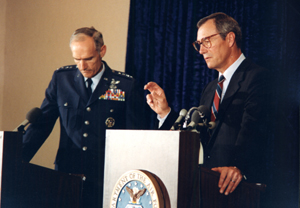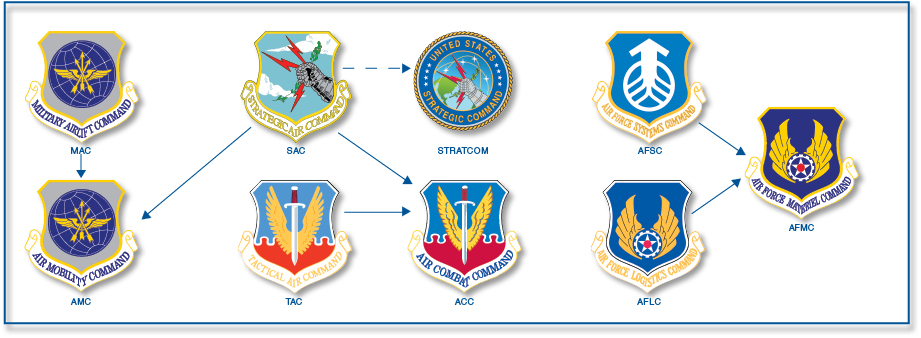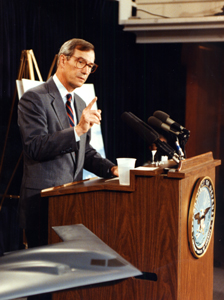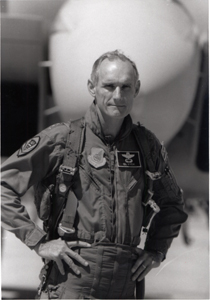The Air Force was born of the Cold War, a conflict that defined the service and shaped its forces, organizations, and focus for decades. Then, in the late 1980s and early 1990s, the Cold War came to an end faster than almost anyone predicted even a few years earlier. The Berlin Wall came down in 1989, Germany reunited, and the Soviet Union dissolved in December 1991.
Where would the Air Force go from there

| ||
|
Gen. Merrill McPeak (l) and Air Force Secretary Donald Rice speak jointly to reporters at the Department of Defense. Air Force reorganization was a top priority for them. |
The Air Force had already debuted a new strategic framework backed by a sweeping reorganization. This was the handiwork of Secretary of the Air Force Donald B. Rice and Chief of Staff Gen. Merrill A. McPeak. “The Air Force was not—and could not afford to be—on autopilot,” Rice later wrote.
Out went the singular focus of US defense strategy: the confrontation in Europe. In came a new national security strategy in March 1990. The strategy embraced the end of the Cold War and prepared for an uncertain “new world order” where the main military challenges would come from regional conflicts.
“As we’re pulled on the one hand by a changing world and on the other by a constricting budget, a fundamental question emerges: What role will the Air Force play in a new world order?” asked Lt. Gen. Jimmie V. Adams, then USAF deputy chief of staff for plans and operations, in 1990. “The answer is increasingly clear: a role that is the essence of airpower—the ability to react fast, far, and overwhelmingly.”
Rice quickly captured this essence in “The Air Force and US National Security: Global Reach, Global Power,” a short paper published in June 1990.
The paper’s main thrust was introducing a new structure for airpower in national defense—in scenarios from humanitarian operations to major theater war. Conventional forces were essential for regional conflicts, so the new force planning called for “an increased emphasis on force projection capabilities—even more flexible, rapidly responding, precise, lethal forces with global reach.”
The White House also put the services on notice that it was time to reform. President George H. W. Bush advocated “not merely reductions, but restructuring” of the military in a speech in Aspen, Colo., in August 1990.
What to do next ended up squarely in the hands of Rice and a new Chief of Staff, McPeak, who took over in October 1990 when his predecessor and friend, Gen. Michael J. Dugan, was fired after just two months on the job during the buildup for the Persian Gulf War.
“I went in immediately to Don Rice’s office,” McPeak recalled. “I said, ‘Let’s reorganize the Air Force.’ He said, ‘OK, how do you want to do it?’ “
McPeak served as a fighter pilot in the 1960s, including combat time in Vietnam. He’d come up in a rough working-class childhood with no father, and the Air Force opened up another world for him. As a general officer, he worked on the US Air Forces in Europe staff, held the Air Staff’s top programs and resources job, and commanded Pacific Air Forces from 1988 to 1990.
Rice came from a business-oriented family and his father was mayor of Frederick, Md. Rice earned a degree in chemical engineering from Notre Dame, served in the Army, and worked as a “Whiz Kid” in the McNamara Pentagon before taking over RAND Corp. in 1972, at age 32. He transformed RAND from a boutique Air Force think tank to a broad-based policy institute serving the Air Force, Army, and other DOD agencies and doing research for the federal government.
Rice and McPeak were cool, cerebral personalities. Both in their early 50s, they were professionals at the top of their game and seized the chance provided by fast-moving events to remake the Air Force.
 | ||
|
Yes, it was as complicated as it looks. |
The time was right, despite the hectic pace of events leading up to Operation Desert Storm.
The Goldwater-Nichols Act of 1986 had taken the military departments out of the warfighting chain and gave a service Secretary and Chief considerable room to maneuver in the areas of organizing, training, and equipping the services.
McPeak wanted to move fast. He felt a four-year term was not much time to drive change into the fabric of USAF. “I saw organization as my job,” he said.
Rice was ready, too. “He let me do stuff no other Secretary would have had the courage to do,” McPeak later said.
“By Dec. 31, 1990, Rice and I had made all the fundamental decisions,” McPeak recalled. “Including some mistakes we made.”
It was not just the end of the Cold War that drove them. Both were motivated by deep convictions about how to optimize USAF. “It was a desire to make a stronger Air Force,” McPeak said.
To be sure, USAF budgets were tumbling. The four fiscal years from 1990 to 1993 saw USAF’s budget decline from $103.6 billion to $83.9 billion, as measured in constant Fiscal 1993 dollars. Still, strategy came first. The Air Force “focus is on evolving US national security needs,” Rice wrote in “Global Reach, Global Power,” and “not simply on fiscal constraints, though they too are real.”
“We would want to pursue these initiatives even if there were no budget pressure to do so,” McPeak insisted as the reorganization took hold. The summer of 1992 found USAF upending organizational structures from the squadron level to major commands. Soon the Cold War behemoth Strategic Air Command was gone and massive decentralization across the service pushed general officers out of headquarters staffs to command wings at bases.
SAC, MAC, and TAC
By the time Rice’s and McPeak’s initiatives were fully implemented, practically every airman in the force had a new master and the Air Force was primed for an era of expeditionary operations.
With Rice’s new strategic framework in place, it was time to focus the Air Force on what McPeak saw as its core task: prevailing in “manned, winged combat,” in his words.
This streamlined operational philosophy prized simplicity and eliminating clutter at every level of organization from bases to major commands. “What’s important around here?” was the question McPeak asked himself.
Perhaps the No. 1 goal was achieving greater agility for airpower in regional conflicts small and large. That called for command reorganization to better integrate forces. McPeak had experienced problems with force integration while he commanded Pacific Air Forces.
PACAF had C-130s at Yokota AB, Japan, but they belonged to Military Airlift Command.
Similarly, Strategic Air Command owned the tankers based at Kadena AB, Japan.
The Persian Gulf War provided momentum to rationalize the command structures. “The unified employment of airpower in Desert Storm confirmed that change was needed within the Air Force,” Rice later explained.
Rice and McPeak had plenty of latitude for change, and as soon as Desert Storm ended, hints of the reorganization emerged. First up were SAC and Tactical Air Command.

| ||
|
Rice briefs the press corps on the B-2 program in 1992. Rice and McPeak made Air Combat Command the centerpiece of the post-Cold War Air Force. (DOD photo by R.D. Ward) |
“I never could understand the difference between a bomb dropped from a bomber and a bomb dropped from a fighter,” McPeak said. “What separates strategic from tactical? The target doesn’t care.”
Desert Storm wiped away the strategic and tactical distinctions, as F-117 fighters flew strategic missions and B-52s provided tactical, front-line support.
Rice and McPeak decided to create one single command—Air Combat Command—as the centerpiece of theater airpower.
“Air Combat Command will possess all the bomb dropping, bullet shooting, and support capabilities that we know must be integrated in modern air combat,” McPeak said at the time. “In other words, it will itself be able to conduct independent, integrated air operations.”
The subtext here resonated with issues raised by Air Force operations from Vietnam through Desert Storm. In those conflicts, SAC had kept jealous control of its bombers and its crucial tankers. Regional air force commanders had to work out agreements with SAC for use of their assets, as SAC still had a nuclear deterrent to maintain. However, commanders chafed at having to deal with SAC while also deploying and fighting.
Dismantling SAC, long viewed as the crown jewel of Air Force organizations, was no easy task. The storied command was a Cold War icon, steeped in tradition and prestige. Step 1 was the retirement of SAC Commander Gen. John T. Chain Jr., who “would never have acquiesced” to the command’s dissolution, said McPeak.
McPeak believed that intercontinental nuclear war was not solely an Air Force mission. SAC had led the way in the first years of nuclear deterrence, but the mission had become joint at the end of the Eisenhower era. The Joint Strategic Target Planning Staff was created in 1960 to convert broad national strategy into the detailed single integrated operational plan.
Going forward, Rice and McPeak wanted conventional bombers ready for theater warfare. Hence came the need to break bombers out of SAC.
“The impetus for disestablishing SAC was to integrate manned, winged combat forces,” McPeak said. “That’s why the manned bomber force had to come over.” McPeak proposed to Army Gen. Colin L. Powell, Chairman of the Joint Chiefs of Staff, that SAC convert to a new joint command with leadership rotating between the Air Force and the Navy. US Strategic Command, based at the SAC headquarters site of Offutt AFB, Neb., would oversee DOD’s nuclear planning and warfighting.
USAF leadership did not worry about preserving the nuclear culture of SAC because TAC had a nuclear mission, too. McPeak and countless other commanders in TAC had long experience with nuclear training, alert missions, and weapons handling. “I had 300 nuclear weapons at Upper Heyford [UK], and no one was better at keeping track of them than me,” McPeak said.
What about the ICBMs? McPeak decided they, too, were “shooters” and ordered them to ACC, which was based at TAC’s old headquarters of Langley Air Force Base in Virginia.
“That was stupid and I undid that as quick as I could, without it looking like I spilled ketchup on my tie,” he said later. “It made no sense to move the ICBMs to Langley.” He chalked the ICBM decision up to being too eager to get the reorganization under way.
On another point, he hesitated—and later regretted it. “It was a mistake not to put all tankers at Langley” under the control of Air Combat Command, McPeak later said. “There is no capability more critical to theater air warfare than air refueling.”
On June 1, 1992, Rice and McPeak stood up ACC in the morning then flew to Scott AFB, Ill., to turn Military Airlift Command into Air Mobility Command. “We now understand that the real requirement is for mobility—that is, deployability and sustainability in combination,” McPeak said at the ceremony.
Air Combat Command was based on strong principles about how air forces should deploy for war. McPeak wanted ACC to pick up and fly off to war fast. Little did leaders realize how quickly it would be tested, as expeditionary operations soon began to dominate Air Force operations. The task of sending expeditionary air forces to numerous locations on a moment’s notice was greatly facilitated by the new ACC and AMC commands.
Other changes moved on apace. Field operating agencies were restructured, too.
“We needed to look at every echelon down to squadron level and ask: Is this as simple as it can be?” McPeak later said. “If structures are not simple they will fail.”

| ||
|
McPeak during his tenure as PACAF chief. As USAF Chief of Staff, he moved fast to implement organizational changes within the Air Force. (USAF photo) |
Breaking up functional stovepipes was another major goal. Weather was one of the best examples. At one point in time, the Air Weather Service was part of MAC and boasted 5,000 people and six weather wings. Rice and McPeak took it apart and set up a field operating agency with 1,100 people, headed by a brigadier general reporting to the Air Staff. The change shed people, put policy at headquarters, and decentralized operations out of Washington. It was textbook for what the Chief and Secretary wanted.
The bulwark of the Rice-McPeak changes was the concept of one base, one wing, one boss.
Previously, colonels usually commanded combat wings. McPeak himself had been a colonel when he commanded the 20th Tactical Fighter Wing at Upper Heyford.
Now Rice and McPeak wrung billets for general officers out of headquarters and elevated many wing commands to one-star rank. This was a fundamental change for operational airpower. At the peak, 65 wings out of 115 had general officer commanders. (Today, roughly 18 out of 96 wings are commanded by brigadier generals.)
Some changes have occurred since, but the structure has endured. Wings acquired operations, logistics, and support groups as cornerstones of wing organization. This provided “accountability for mission accomplishment,” Rice and McPeak noted in a September 1991 white paper.
Another innovation was the creation of composite wings of multiple types of aircraft. This did not take root so deeply, but it did push USAF thinking on how to prepare forces for air intervention.
Systems + Logistics = Materiel
Air Force Systems Command and Air Force Logistics Command suffered similar fates as SAC and TAC.
The four-star Systems Command housed at Andrews AFB, Md., had been so redesignated in 1961 after several years of debate about how best to handle research, development, and risk management. Post-World War II reviews by luminaries such as Theodore von Karman and Jimmy Doolittle had long recommended a separate R&D command.
McPeak believed Systems Command had been essential in the large-scale developments of the 1950s and early 1960s and a key ingredient in winning the Cold War. “There was a period when we needed a four-star Systems Command,” he said.
By 1990, technology had moved on. The civilian sector, not USAF, led information technology development. With the SAC, TAC, and MAC reorganizations, Rice and McPeak were guided by operational experience. They had less to go on in structuring what remained of USAF-led research, development, acquisition, and sustainment.
Personnel reductions were a factor. “We decided nationally we had a Cold War legacy which we would cash in on,” recalled Gen. Lawrence A. Skantze, who led Systems Command from 1984 to 1987.
But there was more to the story. The Goldwater-Nichols reforms removed most acquisition authority from service major commands and into a chain of authority running from the Office of the Secretary of Defense to the service Secretariat’s acquisition deputies. “We no longer need to provide four-star leadership for what has become, in important respects, an administrative support activity,” explained McPeak.
The operators also had beefs with Systems Command, which “produced pretty good equipment, but when they handed it off, [the operators] found it was hard to maintain,” McPeak recalled. This was more a symptom of increasing complexity in the weapon systems, but in 1990, many thought better planning would solve the problem.
Skantze confirmed that by 1990 there was little love lost for Systems Command outside of the organization itself. Previous chiefs had “encounters with Air Force Systems Command which left somewhat of a bad taste,” said Skantze. Likewise, “Don Rice had been president of RAND and had several encounters with the Systems Command hierarchy.” The net result, according to Skantze, was that “the idea of abolishing Systems Command did not seem to be too difficult.”
McPeak said the primary goal for merging Air Force Systems Command with Air Force Logistics Command was to create “one commander responsible for life-cycle weapon system support.” In line with other themes of the reorganization, the merger reduced headquarters while keeping power and resources in the field. “In the process, we liberate 17 more general officers,” McPeak noted at the time.
Beyond this, it was thought that the new Air Force Materiel Command could reduce maintenance and depot costs by anticipating requirements early in system design—”If it all works like we hope,” McPeak added.
“It was done very quietly, in camera,” Skantze said of the decision.
The merger was the last moment of silence. McPeak soon found himself vociferously defending the move.
There lay the problem. “Following World War II and on the eve of the greatest takeoff in aeronautical engineering technology, the essential difference in management of aircraft logistics support versus contracting for research and development was recognized as a distinction of first importance,” wrote author and analyst A. G. B. Metcalf. “Those differences are just as true and far greater today,” Metcalf said.
Skantze concurred. “I think the problem was that Systems Command and Air Force Logistics Command had entirely different philosophies. The two didn’t match up very well.”
The logistics focus of AFMC was a success, but the Air Force struggled to repair lasting damage to its acquisition capabilities. Skantze felt that the AFMC commander had no leeway to rebuild acquisition or conduct summits and quarterly program reviews. The AFMC commander “is staggering under the requirements for intensive logistics support to Air Force flying and ground forces half a world away,” Skantze pointed out. “It is a continuous 24/7 challenge that outranks any other concern.”
Honing the Bayonet
Harder to gauge was the overall loss of finesse in managing research and development. However, the transfer of power to OSD was already a fait accompli.
“We had lost our deputy chief of staff for R&D,” said McPeak. The authority “moved over to an assistant secretary of the Air Force for acquisition.” He and Rice sparred over who would hold requirements authority. McPeak wanted requirements in the XO requirements shop, the forerunner of today’s A3/5, but many billets were moved to the Secretariat’s side.
“You mean to tell me you want civilians saying how sharp the bayonet has to be?” McPeak demanded of Rice.
Responsibility for setting requirements came back to the Air Staff.
Ultimately, the end of the Cold War gave Rice and McPeak a golden opportunity and they took full advantage of it.
As they knew, their restructuring ultimately touched “every man and woman in the Air Force.” In less than two years, six four-star Majcoms were consolidated or renamed and significantly revamped.
The change continued at a slightly lower level as well. A series of major commands led by two- or three-star generals also lost their stand-alone Majcom status. Air Force Communications Command, Air University, Alaskan Air Command, and Air Force Intelligence Command all ceased to be major commands between 1990 and 1993. The reorganization left behind an Air Force with a flatter organization, clear priorities, and a meaty slogan in “Global Reach, Global Power.”
The simpler structure was not set up to feed operations in Iraq, Bosnia, Kosovo, Afghanistan, and around the world. Yet that was exactly what it did, creating the building blocks for the expeditionary air force rotational structure developed by future Chiefs of Staff Gen. Michael E. Ryan and Gen. John P. Jumper in the 1990s and 2000s.
Rice and McPeak were not shy about explaining each step. Dry humor crackled on occasion. “Our tenure has been characterized by change—I hope, constructive change,” McPeak said in the midst of it all in June 1992. “Others might call it turmoil, even confusion!”
There were many more innovations. McPeak had come to believe training was more important than equipment and well worth a four-star command. “Rank is the best sign of sincerity in the military,” he said, and the three-star Air Training Command consequently became a four-star major command in December 1992 and was redesignated Air Education and Training Command in July 1993.
Certainly USAF was lucky in having two bold leaders committed to the unique vision of how the Air Force served America.
The strategic vision brought the Cold War focus to an abrupt end in the best possible way: by clearing the path to remake the Air Force into a structure exquisitely in touch with the uncertain future operational environment.
“Are we properly organized?” said McPeak. “That’s something every Chief should ask.”